International Journal of Structured Assocoation Technique No.2 pp.63-75
Original Article
Shift in Frequency of Voice Accompanied with Emotional Change in a Cancer Patient
Kei-Ichiro Kobayashi* and Tsunetsugu Munakata**
(SAT Therapy Project, University of Tsukuba)
"Vivid Life" Counseling Room, Tokyo*
Department of Human Care Science, University of Tsukuba, Tsukuba**
Correspondence: Kei-Ichiro Kobayashi
"Vivid Life" Counseling Room, 3-38-10 Miyoshi-Cho, Fuchu-City, Tokyo, 183-0045 Japan
Tel/Fax: 042-361-5363. E-mail: k.-i.kob@jasmine.ocn.ne.jp
Abstract
The shift in the frequency of voice of a breast cancer patient through SAT imagery therapy was studied with FFT-analysis. The frequency of "AH" in a Japanese word "OKAHSAN" (or "mother" in English) remarkably decreased from 293-312Hz to 137-185Hz with a change of imagery of her parents to the ideal ones. However, in the therapy where she strongly suppressed her negative emotion with fear of death, a disagreement between verbal (the content of talk) and nonverbal (frequency) was observed. These results show that (1) the frequency of AH generally decreases with the improvement of the emotion in the client, (2) the frequency shows an irregular behavior with suppressed subconscious emotion. Therefore, it is found out for the first time that the frequency of "AH" in the Japanese word "OKAHSAN" can be used as a scale of human emotion.
Key words: SAT imagery therapy; cancer; frequency; voice; emotion; FFT-analysis
I. Introduction
Information is sent and received in the form of wave which is accompanied with frequency such as light, sound, and electric signal. In the case of information concerning human emotion, vocal expression, facial expression and behavioral expression are very important factors(1). In counseling, vocal conversation is the main medium of interaction between client and counselor. A counselor instinctively accepts a lot of emotional information from the vocal expression of a client. Therefore, it is expected that by analyzing the voice of clients we can obtain a clue to solve human emotion scientifically from a new point of view.
By applying SAT imagery therapy to many cancer patients for several years, not only psychological scales but also physiological data, such as immune function and expression of tumor-suppression genes, have been improved (2,3,4). Among various tumor-suppression genes, p53 and RB are reported to be very important to prevent and diminish cancer(5). This indicates that resolving the relationship between mental situation and physiological situation evaluated as the expression of tumor-suppression genes are very important to reduce the number of people who die of cancer.
Hori et al. studied the expression of genes by analyzing the crying of rat with FFT-analysis. Tickled rat gave a peculiar crying with a unique component frequency of 50kHz in the ultrasonic region. In the brain of ticked rat, expression of genes was confirmed(6). From this point of view, we started researching the change of vocal expression of clients whose physiological data including tumor-suppression genes have been improved prominently through a series of SAT imagery therapies. In our daily life, we speak relatively higher interval in a nervous feeling, and lower interval in a relaxed feeling. Therefore, as the first step, we noticed the frequency of voice. Consequently, we have detected a very characteristic behavior of vocal frequency, and as a result, found out that vocal frequency can be used as a scale of not only unconscious emotion but also that of subconscious emotion.
II. Experimental
2-1. Application of SAT Imagery Therapy to Cancer Patient
After explanation of scientific grounds of SAT imagery therapy to cancer patients and obtaining their written consent, we started the therapy. We took blood samples to evaluate the immune function and the expression of 4 tumor-suppressor genes; p53, RB, BRCA2, RUNX3. Details of the procedure have been reported in a previous paper (3).
2-2. Personal Background and Medical History of the Patient
Patient in this study was a 46-years-old woman. Her mother was very emotional and had a tendency of controlling her and her elder sister. Left breast cancer was recognized at the end of July 2001. The main subject of this patient throughout SAT imagery therapy was a conflict with her mother and sister. Her detailed profiles have been reported in the previous issue(3,4).
After three to four times of therapy, her psychological scales had been improved and kept this condition since then. Her immunity and the expression of tumor-suppressor genes showed a gradual improvement, and the final stage of her 26 times of SAT therapies satisfactory data were obtained continuously(3,4).
2-3. Analysis of the Frequency of Voice
The frequency of digitally recorded human voice was analyzed using Ono-Sokki DSO221 FFT-software. In this study, Japanese words "OKAHSAN" and "OTOHSAN" were adopted for "mother" and "father" (in English), respectively. In these words, the long vowels "AH" and "OH" were chosen as the object of FFT analysis, as underlined in Roman alphabetical expression above. The reason is (1) long vowel is adequate for the accuracy of analyzing position, (2) the same vowel in the same word should be analyzed because we pronounce the same vowel in another words in different frequencies even in the same mental situation, (3) frequently spoken words in the counseling are desirable to get plenty of data, (4) we must choose any object word which reflects the human emotion with high sensitivity. Between these two words, "OKAHSAN" (mother) was used mainly and "OTOHSAN" (father) was used complementally.
At first, the voice of a counselor (a late 50's man) was analyzed in order to demonstrate that the frequency of human voice can be used as an index of human emotion. In the case of the counselor, three types of expressions were picked up; (1) strongly affectionate and soulful situation when he was telling the "magic soulful words" to the client, (2) fairly emotionless situation when he asked real or traumatic images to her, (3) slightly affectionate situation where he repeated the ideal and desirable images of her. This was recorded through a psychic counseling to a client without cancer using rebirth and rebearing imagery technique.
In the case of cancer patient, FTT analysis was carried out only for "AH" in "OKAHSAN" in the 1st , 2nd , 4th and the 25th sessions. Situations when "OKAHSAN" was pronounced could be separated into two cases. The first case is that when the client pronounced "OKAHSAN" with positive expression of her mother, and the second case is with negative expression. In this case, only the word "OKAHSAN" was analyzed because this word was spoken more frequently than "OTOHSAN".
2-4. Rebirth and Rebearing Imagery Therapy
In Rebirth and Rebearing Imagery Therapy, imagery of parents, grandparents and great-grandparents are changed into ideal ones for the client. At first, actual traumatic images are reminded by Structured Association Technique, then on the ground of these images, ideal images are set. In the course of counseling, counselor asks client about the situation and personality of her parents, and the client answers the real and ideal images of them. Therefore, in this part of the session, both counselor and client said the word "OKAHSAN" and "OTOHSAN" many times.
In this stage, these two words were pronounced by the counselor in two types of tone. The first type is those when the counselor asks her the real image of parents without emotion, the second type is those when he repeats the ideal image of her parents. In this second situation, since the counselor conceives the ideal image of client, tone of "OKAHSAN" and "OTOHSAN" changed to somewhat emotional ones.
After this, the counselor talks to her the "magic soulful words". As is shown below, in the "magic soulful words", counselor says the words "OKAHSAN" and "OTOHSAN" repeatedly.
2-5. "Magic soulful words"
To the clients in ideal in-womb images, the counselor tells soulful and affectionate words. At this point, since the counselor is holding his/her most loving person such as his/her children, the voice of the counselor naturally changed into strongly soulful and affectionate tone. "Magic soulful words" are as below.
- Father and mother are delighted to be blessed with you, and love you very much.
- Father and mother love you whatever you are, we are impatient for you to bear safely.
- If you might have any trouble, be sure to tell father and mother.
- Father and mother will help you with all our might.
- Live in such a way that you will be grateful.
- Father and mother will be most delightful to feel that you live satisfyingly.
III. Results
3-1. Voice of counselor
FTT analysis was carried out for three types of mental situation: (1) strongly affectionate and soulful situation, (2) fairly emotionless situation, (3) slightly affectionate situation.
The result of analysis for both "OKAHSAN" and "OTOHSAN" are shown in figures 1, 2. When the counselor said those words very soulfully telling magic soulful words, frequency of long vowel "AH" and "OH" was in the range of 100~120Hz. On the other hand, when he said them in fairly emotionless situation, frequency was in the range of 150~250Hz. In addition, in slightly affectionate situation repeating the ideal images, frequency was in the range of 120~150Hz; the middle range of two situations mentioned above. Therefore, as a result, frequency of long vowel "AH" and "OH" in "OKAHSAN" and "OTOHSAN" decreased from the range of 150~250Hz to that of 100~120Hz, with increasing soulfulness in the mental situation of the counselor. This shows that We are able to use the frequency of "AH" and "OH" in these two words as a scale of subconscious emotion.
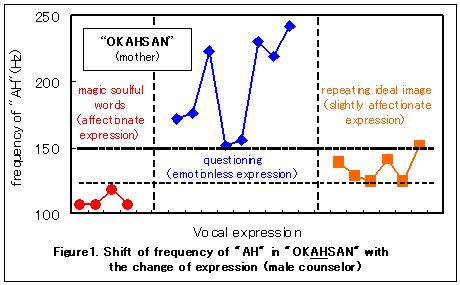
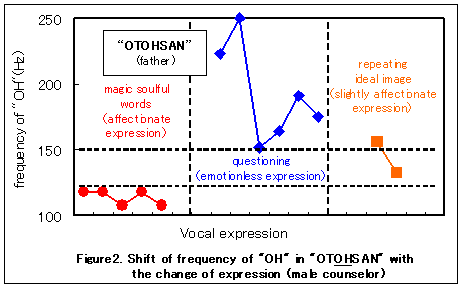
3-2. Voice of cancer patient
In the 1st session, remarkable shift was observed in the frequency of "AH" in "OKAHSAN". Since this is the first session, she told the impression of her mother to us frankly. She said "My mother scolded me severely in front of my friend" and "This mother is incredible." In these negative expression, as shown in figure 3, frequency of "AH" was as large as 293-312Hz. On the contrary, having desirable image of her grandparents and great-grandparents through the first session, frequency decreased to 137-185Hz; about 1/2 of that of negative expression. From the viewpoint of musical interval, the effect of ideal image is as wide as one octave. At this stage in an ideal in-womb image, she expressed her mother like this, "An affectionate mother is ideal", "When I am born, mother welcome me".
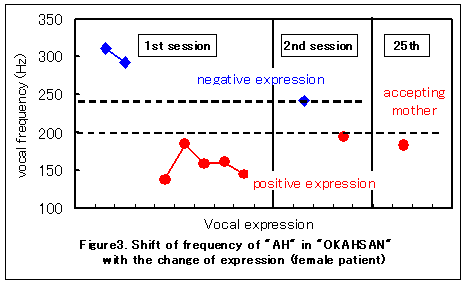
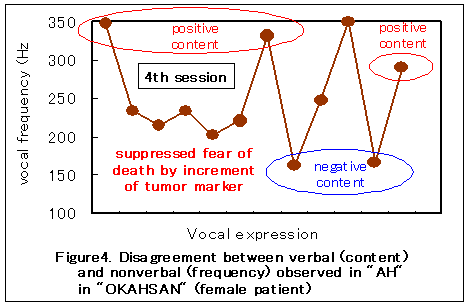
In the 2nd session, a similar change in frequency was observed as in the 1st session (Fig. 3). In the 4th session, apparently incomprehensible results were obtained. In figure 4, some large frequency data were observed in the positive expression of "OKAHSAN", and some small frequency data were obtained in the negative expression. This was reversed behavior of the frequency to those observed in the 1st and the 2nd session. When she said " Mother is in a severe atmosphere by being accused " and " It makes no difference even if we return to Japan without mother at the end of the world war ", observed frequency was 162-167Hz; in the range of small frequency. On the contrary, when she said "Mother is expecting baby in a relaxed feeling " , "Affectionate mother" and "I feel mother is satisfied and happy" frequency was 331-350Hz; in the range of large frequency. There exists a disagreement between verbal (the content of talk) and nonverbal (frequency). This disagreement is the characteristic of the 4th session.
The 4th session was done under strongly suppressed mental situation. At the end of every session, blood sample was taken in order to check the immunitive force, such as the ratio of lymphocytes and neutrophils, and tumor markers. These data were told to the client at the beginning of the next session. As shown in figure 5, at the end of the 3rd session the data of BCA225, a kind of tumor marker for breast cancer, made a sudden increase to 201U/ml which is higher than the standard value (160 U/ml). When the client was told this increase at the beginning of the 4th session, she perceived this as the reoccurrence of cancer with a fear of death. On the other hand, the ratio of lymphocytes and neutrophils at the end of the 3rd session, a scale of the balance between sympathetic nerve and parasympathetic nerve are in their standard range. On the contrary, at the end of 4th session, BCA225 decreased to the standard range and the ratio of lymphocytes and neutrophils became worse, suggesting she had a heavy stress to know the increase in BCA225. Her strong fear was not expressed in the 4th session, but expressed at the 5th session after being told of the decrease of BCA225. She said "I'm very glad to hear that. I was so shocked to know the increase in BCA225 that I couldn't speak my fear in the last session. Although I had told you I became positive through SAT therapy, I couldn't eat meal for a few days after the last session."
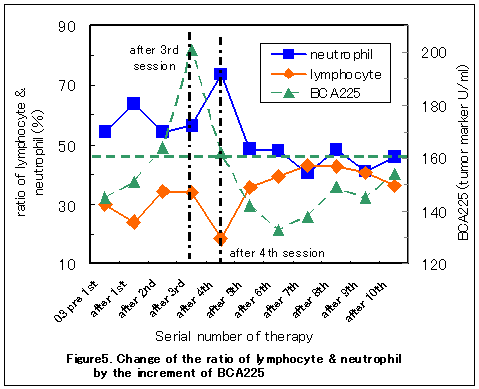
In the 25th session, she said "OKAHSAN" only once. She told us the recent relationship between her mother. She said, she talked to her mother "Mother, you appear to me, even if you fawn on others you would not become happy". Although the content of this conversation is rather negative, analyzed frequency was 183Hz; in the range of low frequency. She continued "By setting estrangement from my mother, she changed not to ask me what would I do today. She understood the reason. Consequently, relationship between my elder sister was improved. I feel the prospects for the future are very good." She told about her mother very frankly. Her talk held both positive and negative contents. But as a whole, she accepted her mother as she was. Since the main subject of this patient is a conflict with her mother and sister, this small frequency confirmed that her therapy could be concluded.
IV. Discussion and Conclusion
FTT-analysis applied to the voice of male counselor shows that the frequency of "AH" and "OH" in "OKAHSAN" and "OTOHSAN" decreased from the range of 150~250Hz to that of 100~120Hz with increasing soulfulness in the mental situation of the counselor. This shows that we are able to use the frequency of "AH" and "OH" in these two words as a scale of unconscious emotion.
Also in the case of female cancer patient, the frequency of "AH" and "OH" in "OKAHSAN" and "OTOHSAN" decreased through the SAT imagery therapy in each session. The most remarkable decrease was observed in the 1st session, where the frequency of initial negative expression spoken in 293-312Hz decreased by half to 137-185Hz in the positive expression. In the 25th session, although she spoke about her mother including both positive and negative aspects, the frequency or "AH" in "OKAHSAN" was pronounced at 183Hz; the frequency range of positive expression. Very peculiar reversed behavior of the frequency was observed in 4th session. This behavior agrees with the strongly suppressed extraordinary mental situation of the client, suggesting a disagreement between verbal expression (the content of talking) and nonverbal one (frequency). Taking all these results into consideration, it can be concluded that the frequency of "AH" and "OH" in "OKAHSAN" and "OTOHSAN" can be used as a scale of not only unconscious emotion, but also subconscious emotion of human being with high sensitivity.
Human voice is pronounced by the vibration of the vocal cords. The frequency of string is expressed by the next formula.
ν=(j/2l)(T/σ)1/2 (j=1,2,3・・・)
(ν: frequency, l: length, j: 1,2,3・・・(integer), T: force, σ: linear density)
According to this formula, when a person get nervous, he or she unconsciously strains the muscle in the vocal cord more strongly, consequently the frequency of the voice increases. This qualitatively agrees with the observed phenomena.
References
- Munakata, T.: SAT Health Psychotherapy Supports our Revolutionary of Way of Life, Journal of Health Counseling, 14:1-10, 2008.
- Munakata, T.: Building SAT Therapy to Activate Anti-Cancer Genes and Immunologic Function for Cancer Treatment. International Journal of Structured Association Technique, Electronic Journal of Social Skill, Counseling and Imagery Therapy, 1: 3-35, 2007.
- Kobayashi, K.-I., Hashimoto, S., Hayashi, T., Sakamoto, S., Hori, M., Obitsu, R., Murakami, K., & Munakata, T.: Treatment of Patients With Cancer for Stressful Emotion Transmitted from Ancestry by Using Genetic and Immunologic Data as Barometers. International Journal of Structured Association Technique, Electronic Journal of Social Skill, Counseling and Imagery Therapy, 1: 36-58, 2007.
- Munakata, T. and Kobayashi, K.-I.: SAT Imagery Therapy for Cancer, Shunju-sha, Tokyo, 44-68, 2007.
- Morgenbesser, S.D., Williams, B.O., Jacks, T., & DePinho, R.A. p53-dependent apoptosis produced by Rb-deficiency in the developing mouse lens. Nature 371(1): 72-74, 1994
- Hori, M., Urayama, O., Hayashi, T., Nakagawa, Y., Sakamoto, S., & Murakami, K.: Private Communication.